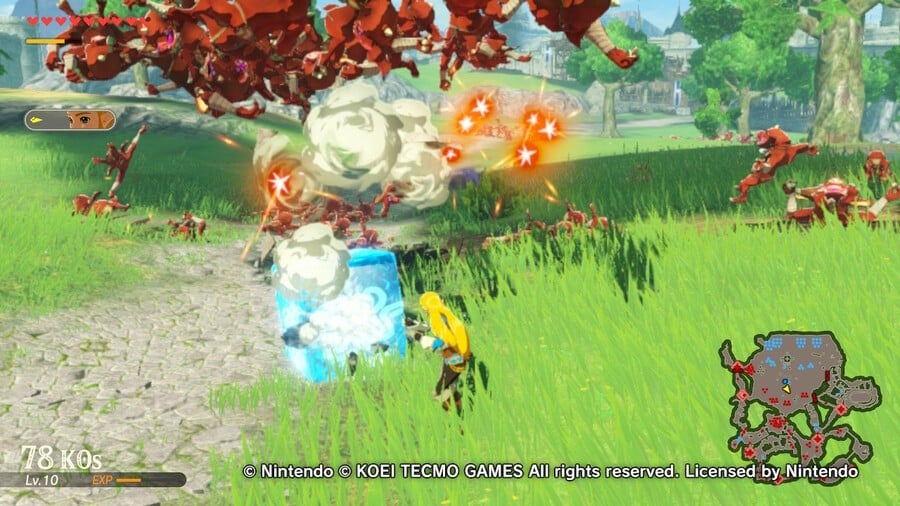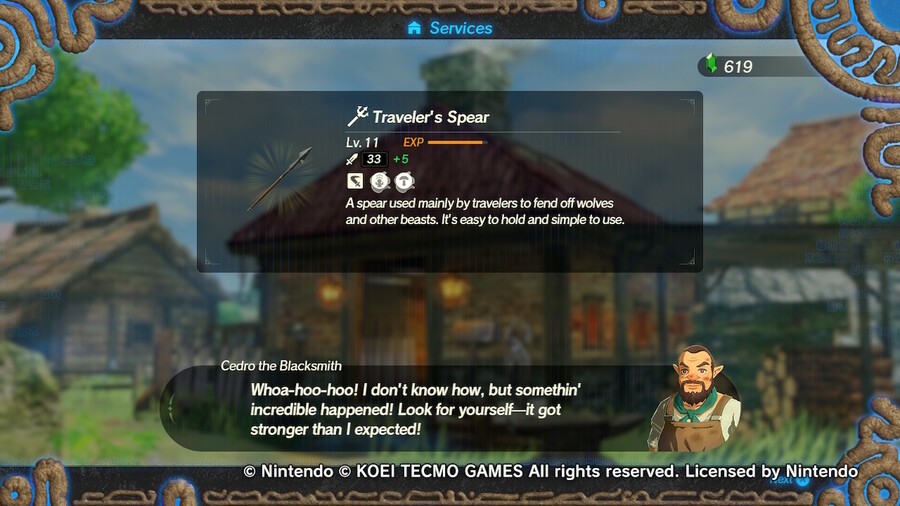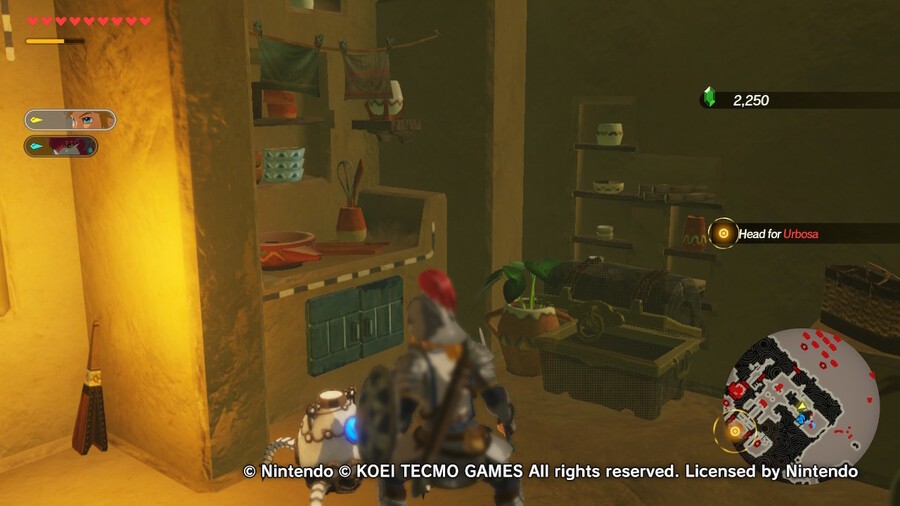
Silence, they say, is golden, and while Hyrule’s own golden boy hasn’t had much to say for many years now — beyond the odd ‘hyaaa!’ or ‘eurghhh!’ — the motormouth cast of Hyrule Warriors: Age of Calamity highlight Link’s stoic silence all the more. These characters spoke a lot in Breath of the Wild, of course, but the density of cutscenes we’ve witnessed in our brief time with the game so far makes their voices (and Link’s silence) all the more noticeable.
Thankfully, all the dialogue is universally well-delivered. Set a century before Breath of the Wild, there’s a surprising amount of narrative to get through in this prequel tale considering the end Age of Calamity is a foregone conclusion (we’re going to assume 99.9% of you played Breath of the Wild already — if you’re the 0.1%, off to the eShop with you). While the story we’ve seen up to the end of Chapter 2 is fairly predictable fare, it’s well-told and helps give some welcome context to the endless cans of whoop-ass being opened otherwise.
This is Koei Tecmo’s second brush with the Zelda franchise following the first Hyrule Warriors. This one, however, appears to have even more of Nintendo’s fingerprints on it, not least thanks to the reams of Breath of the Wild environmental assets presumably made available to Koei Tecmo development division Omega Force. Veterans of that game will recognise areas, although in the heat of battle it can be a little hard to work out how much they’ve been changed and adapted for fast-paced, gated hack-and-slash gameplay.
Fences have been erected alongside the natural environmental barriers to funnel you to outposts across Hyrule’s various battlefields. You may come across familiar towers or structures with haystacks dumped on staircases to prevent access, and it’s a bit jarring at first to bounce off walls and other surfaces rather than clamber up them as a Stamina Meter depletes. Indeed, there’s no stamina here (which means you can leg it across the terrain at full pelt indefinitely), and no weapon degradation, either (instead, found weapons can be fused and made stronger at the Blacksmith’s).

And the ability to climb surfaces is also absent (hey, it took 100 years of meditation and training for Link to become a champion climber, okay!). Instead, you’ll see a “Wall Jump ‘B'” tip crop up when you push against a wall, rock or fence. The camera does its best in these situations — you lock on to significant enemies and Captains using ‘R’ — and the best tactic is usually to continue your combo even if you can’t quite make out where you are in the confusion of crowd combat,
The fact that the game looks like Breath of the Wild doesn’t mean it controls the same, and it took us half an hour to make that mental adjustment; to stop ourselves tapping ‘X’ to jump — that sort of thing. Overall, though, the conceit that you’re 100 years in the past arguably justifies the new/old fences and barriers, and the combat is easy to slip into once you get over that initial hump.
Anyone who’s played one of Omega Force’s many Warriors titles (or the free demo on the eShop) knows the score when it comes to the basic Warriors gameplay. Age of Calamity’s main story is told through cutscenes bookending battles against endless hordes of Bokoblins and other baddies strewn across large battlefields, with outposts to take over and Bosses to defeat across the map — here a carefully cropped zone of the Hyrule we all know and love. Depending on the narrative requirements, you choose up to three unlockable warriors and switch between them at will to complete tasks across the battle zone. When not in your direct control, warriors will continue to fight, although managing their health and progress by efficiently switching between them is all part of the game.
Normal attacks are on ‘Y’, strong attacks on ‘X’, and over the course of the game you unlock extra combos — four taps of ‘Y’ become five, six, etc, and hitting ‘X’ at the end unleashes a variable strong attack. Each character has a bespoke move set, which also extends to the Sheikah Slate Rune abilities: Magnesis, Stasis, Remote Bombs and Cryonis. So, Link will throw bombs when you hold down ‘R’ and hit ‘Y’, whereas Zelda will summon a guidable walking bomb that spews explosives for a brief period. Discovering how each character employs these common abilities is a great excuse to try out different characters — including the Four Champions — and while we expected to default to Link much of the time, we found ourselves sticking with other characters long after the story allowed us to switch back.
Those Sheikah abilities play into combat nicely, with certain enemy attacks vulnerable to a particular (signalled) Rune ability; use the right one and you’ll have a window to chip away segments their guard shield and unleash a Weak-Point Smash with ‘X’. Throw in a well-timed dodge on ‘B’ which can produce a slow-motion Flurry Attack (just like in BOTW) and skilled players can rapidly deal with big enemies.
You also get the chance to pilot Divine Beasts in shooter-style sections which, while offering something different, lack the balletic appeal of the combat elsewhere. It can be tough to make out the tiny enemies underfoot, and we were thankful that the sections we’ve experienced so far were mercifully short (compared with the main battles, some of which lasted upwards of 20 minutes).
Outside of the main scenarios, BOTW’s Hyrule map is littered with different objectives to complete. The smallest of these involve handing over spoils you’ve collected in battle (Bokoblin guts, Lizalfo tails, fish — that sort of thing) in exchange for opening menu-based shops and services, unlocking new moves for your characters and gaining recipes and other bonuses. Handily, these waypoints flash when you’ve acquired the requisite materials, and you unlock the ability to track quest materials, too. Completing these missions improves the morale of residents in each region, who gift you further rewards.
There’s plenty to unlock, then. Rather than traversing the world, you view the kingdom via your Sheikah Slate map and travel to and from locales via a central Guardian Tower. So, unless the world suddenly opens up for exploration later in the game, you’ll have to wait for Breath of the Wild 2 to go poking around Hyrule’s nooks and crannies. That’s not to say mid-battle exploration doesn’t yield rewards — you’ll find Koroks hiding across the battlefields as well as goodie-filled treasure chests, for example — but it would be a mistake to go into this expecting sedate explorative episodes. This is the age of Calamity, after all, and you’re here to battle the Ganon’s hordes.

Elsewhere, Challenges are battles designed to acquaint you with a specific skill or ability (‘Mastering Remote Bombs’, for example), and completing these trial stages according to the prescribed criteria allows you to level up your character(s) and get some combat practice in. Before entering battles of any sort you can cook meals for various percentage buffs, and you’ll accrue further materials and unlock new stages through victory.
It’s all standard stuff, then, although that lick of Breath of the Wild paint sure does make the menus feel slick and pleasantly familiar. The previous Hyrule Warriors game did a good job of throwing you into the Zelda milieu, but drilling down on one specific game here — the most recent and most celebrated in the series for many years — really fires up your nostalgia, even if it’s for a three-and-a-half-year-old game. The iconography of the map screen alone (from which you pick and choose your battles) will fire up the feels immediately.
You also have a little Guardian buddy who accompanies you and plays into the story. The little chap is essentially a white Sheikah Fabergé egg with legs (imagine BB8 and a hapless turret bot from Portal 2 getting on famously — this is the result) and he provides a shot of levity in a game which could otherwise get very heavy very quickly. After all, regardless of narrative twists and turns, we all know where this story has to end up.

There’s plenty more to talk about, although you’re able to get a taste of much of what we’ve detailed above by playing the demo for yourself. Amiibo can be used once a day on the main menu to gain materials and even weapons. We also haven’t even touched on the local two-player mode here, mainly because we haven’t had the opportunity to try it out just yet.
Our first impressions of the opening chapters of the game are positive, though. With four difficulty modes to choose from, it’s clear that Nintendo and Koei Tecmo have made a real effort here to make this approachable for Zelda fans of all abilities. Throwing a bunch of elements from Breath of the Wild into the Musou mix obviously has its advantages, but it also piles on expectations (what with BOTW being one of the most celebrated games of all time). So far, Hyrule Warriors: Age of Calamity seems to be a good marriage of the two series’ styles, and this game’s Zelda flavour may hold non-Warriors aficionados’ attention long enough to develop a taste and appreciation for that series’ balletic combat and enemy juggling. This has the potential to be the entry point you’ve been waiting for to finally understand the Musou magic, and there’s plenty of other games to dig through if you enjoy that. As for this one, perhaps the best thing we can say about it is that we’re gagging to play more.
Keep an eye out for our verdict on the full game in the future. In the meantime, feel free to share your thoughts so far on the game and demo in the comments below.
